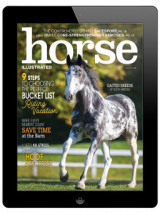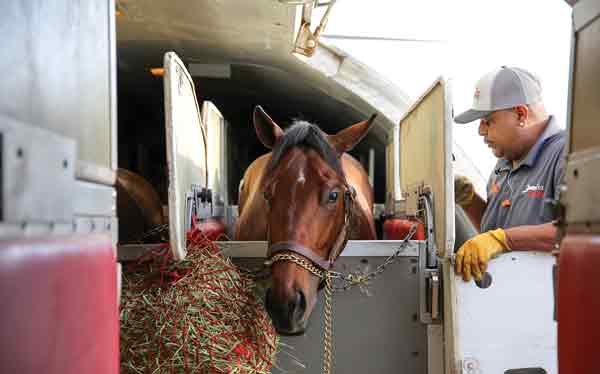
Read to learn about horse industry careers that don’t require a college degree.
“Almost any entry- to mid-level position in the equine industry is in high demand,” says Laurie Mays, equine talent pipeline project manager for the Kentucky Equine Education Project (KEEP) in Lexington, Ky. “Farms, tracks, veterinary clinics, horse shippers, et cetera, are desperate for people with equine handling and industry experience. Someone who is willing to work hard will succeed, no problem.”
Here are some highlights for four equine-related jobs that could serve as a second career or fit into a schedule as a part-time horse job, without the person having to get a college degree.
Horse Transport Driver
JOB DESCRIPTION: This job involves semi-trailer horse transport, short-distance smaller van driving, or pickup truck and trailer driving to move a client’s horses from point A to point B. You must have experience in handling horses. For driving semis, a Class A Commercial Driver’s License (CDL) is required, but for smaller horse vans a Class B CDL is sufficient; a regular driver’s license may be enough for pickup truck and trailer under 26,000 pounds.
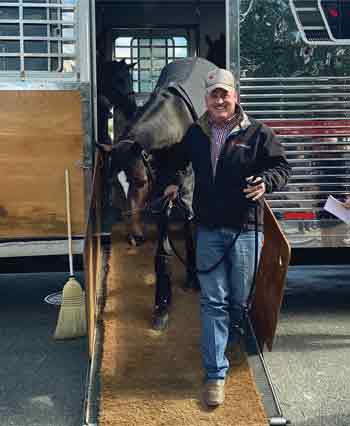
A few years of experience driving semis, a clean driving record and a Department of Transportation certified medical card are also required to land a job driving the “big rigs” for a horse transport company. These companies also offer other jobs, such as dispatchers, office personnel, mechanics and truck/trailer washing and restocking.
WHERE TO FIND JOB TRAINING: Truck driving school can be a good place to start,
but further driving experience is needed in order to drive a horse carrier semi. Some horse transport companies will partner experienced drivers with someone wanting to gain more experience.
The National Horse Carriers Association offers some useful information and contacts on their website (www.nationalhorsecarriers.com).
JOB OUTLOOK/AVAILABILITY: Horse transportation industry leaders report a great need for drivers. Nationally, all types of commercial semi drivers are in high demand.
TIPS FROM INDUSTRY EXPERTS: DJ Johnson, owner of Johnson Horse Transportation in Shartlesville, Penn., has been in the business for 27 years. His wife Elizabeth works with him as well, and they currently run over 30 trucks going to horse shows across North America.
“There are two important things that we look for with our drivers: first is the ability to handle horses and the second is safety,” says DJ. “Drivers need to be available to work weekends, have horse experience and the ability to read the animal. The care of the animals is of utmost importance to us.”
Vonnie Gesinske, 54, of Lexington, Ky., started driving a pickup and gooseneck trailer for Johnson Horse Transport about a year and a half ago. She shares her thoughts about her second-act horse industry career sans specialized degree.
“After meeting DJ and Elizabeth, I decided that getting back into the horse business as a driver sounded like a great opportunity. I had trained and bred Quarter Horses and Paint Horses professionally for over 25 years and been out of it for about 10 years. I was excited to be involved with a company that not only has very high-end show horses to haul, but very nice equipment to drive. Being able to stay local and be home a great deal was the icing on the cake.”
Foaling Barn Assistant
JOB DESCRIPTION: This is a seasonal job from about mid-December through June each year, usually on duty during the night. Working for a breeding farm manager or owner, the foaling assistant keeps watch over pregnant mares, sometimes assists in foaling, and contacts appropriate people (farm manager/owner, veterinarian) for assistance when the mare shows early signs of labor. May also include some stall cleaning, feeding/watering and turnout. Some record-keeping such as noting the mares’ activities at hourly checks and foaling dates and times may be required.
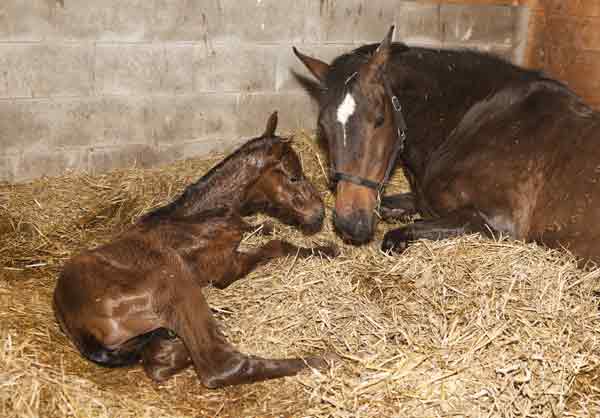
Knowledge of horses is important, especially of broodmares and the signs of labor. Assisting a foaling mare can be a demanding job, so the person filling this position should be relatively physically fit. The job requires a vigilant, reliable person who is intuitive and detail-oriented.
WHERE TO FIND JOB TRAINING: Attend an equine reproductive short course. Several universities and a few privately owned equine reproduction service and supply companies offer them. Volunteer to shadow experienced staff at a farm or a vet clinic during foaling season.
JOB OUTLOOK/AVAILABILITY: This horse career outlook is quite good for those with some experience, especially on larger Thoroughbred and Standardbred farms (and no degree needed). There are also some job openings at farms that breed western performance or English sport horses.
TIPS FROM AN INDUSTRY EXPERT: Ben Tucker of Lexington, Ky., has been in the horse business for over 40 years, including operating a custom foal-watch agency that provides trained personnel to assist in foaling barns on area farms. He lists some key traits a good foaling barn assistant should have.
“You have to be able to stay up at night and not fall asleep; it can be a disaster if you miss a mare starting to foal. Come January 1st, every year the need for people to foal watch around here is overwhelming.”
Horse Show Announcer
JOB DESCRIPTION: Impart knowledge, entertain spectators, and direct traffic, all over a microphone. An announcer must have extensive knowledge of equestrian sports in general, as well as the particular discipline or breed at a show, and also have familiarity with the rule books involved.
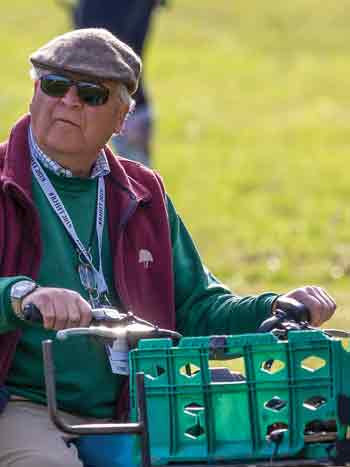
You must be able to multitask and keep a cool head even when things are chaotic; be comfortable using a microphone and electronic sound equipment; and be able to speak in a clear, concise and pleasant manner. And while a college degree in certain areas could provide useful skills, it’s not required for this horse career. Some announcers also provide their own sound equipment to the show as part of their fee. Good people skills and a flexible, quick-thinking nature are important for this job.
WHERE TO FIND JOB TRAINING: Go to large shows/events and observe professional announcers at work; intern with a professional announcer. Volunteer to announce at schooling shows to gain experience. Classes in public speaking, acting, auctioneering or broadcast journalism can all help prepare someone for a career in announcing.
JOB OUTLOOK/AVAILABILITY: Landing an announcing gig at top-level shows and events can be quite competitive, but there are often openings at local shows and events. Working as an assistant to an established professional is also a possibility.
TIPS FROM AN INDUSTRY EXPERT: A native of Devon, England, Nigel Casserley has been “the voice” of a number of FEI-level eventing competitions around North America, as well as FEI-level driving and dressage, the 1996 Olympic Games in Atlanta, and Grade I steeplechase racing. He offers the following advice for anyone interested in this career.
“You have to know the sport and have knowledge of those who are competing in it. When I started announcing, I created rider ‘bio’ sheets for them to fill out. The most important thing is not to get flustered. You have to learn to temper what you are receiving from the other end of a radio and not let it show over the microphone. A great horse show announcer gives the most information in the fewest number of words. And you must be blessed with a voice that amplifies well.”
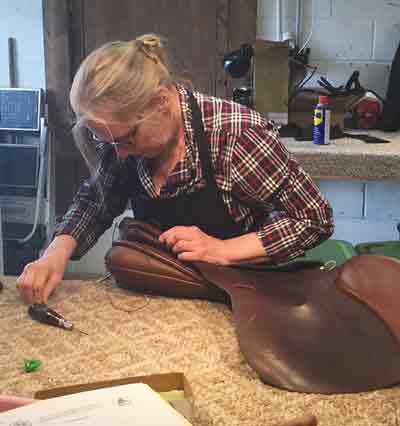
Tack Repair and Saddle Fitting
JOB DESCRIPTION: Work with leather and other materials using hand and machine tools to create and repair saddles, bridles and other leather goods. Saddle fitters use evaluation methods and tools to properly fit saddles to the horse and rider.
Both career paths must have good powers of observation and a working knowledge of horse conformation. Good hand-eye coordination is important for working with the tools. A nice set of hand tools and a leather sewing machine can rack up an investment of as much as $5,000 to $8,000, although a basic set of tools and a stitcher for repairs could be purchased for closer to $2,000 to $3,000.
WHERE TO FIND JOB TRAINING: The North American Saddlery School in Warfordsburg, Penn., offers several levels of classes in saddle and bridle making and repairs, as well as saddle fitting, with the chance for participants to become certified at each level, with the ultimate goal of achieving either a Master Saddler or Master Saddle Fitter designation through the United Kingdom Society of Master Saddler’s guild system.
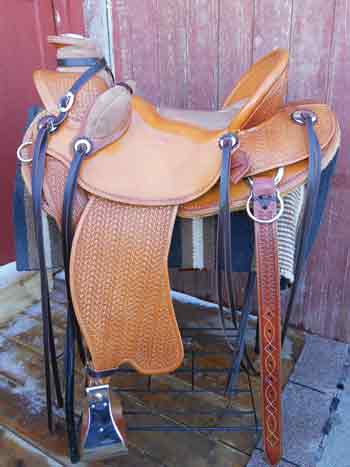
Another option is to apprentice with an experienced saddle maker. There are also other saddle-fitting experts who offer training sessions in saddle fitting, such as Jochen Schleese of Schleese Saddlery.
JOB AVAILABILITY: There is a demand for tack repair and tack-fitting services in North America. Saddle making takes more of a time commitment and investment and is harder to break into than repairs and fitting.
TIPS FROM INDUSTRY EXPERTS: Annette Gavin, a Master Qualified Saddle Fitter and owner of HCS/USA Saddlery, is a driving force behind the North American Saddlery School.
“Our school is a hands-on, one-on-one learning process,” says Gavin. “People come many times over a few years to learn new skills, then go back to practice and do repairs and reflockings before returning to gain more experience. All courses have a certification of completion.
We train for both the English and western market. Our student body is about two-thirds women and one-third men. We have retirees and career changers, as well as young people taking our classes.”
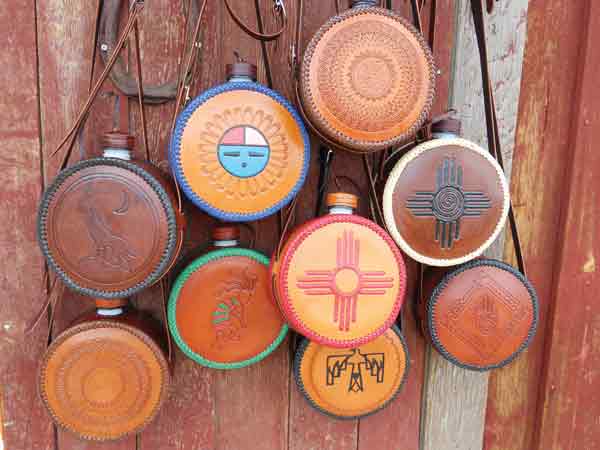
Master saddle maker Clay Sharp of Oregon is also an accomplished farrier and has worked on many ranches across North America, giving him a vast knowledge of equines of all shapes and sizes. He and his wife Robin own Sharp Saddlery, where they have been making saddles, bridles, and other leather goods for over 20 years. Sharp has also taught clinics on saddle fitting and tree making.
“A lot of people tend to focus on the artistry of a saddle, but I think the mechanics of a saddle are far more important,” says Sharp. “We want the saddles to function 100 percent and then look pretty after that. I think a high degree of knowledge of a horse and how it moves is important. Common sense, experience and the ability to learn are also important elements in saddle making. A saddle maker should always be striving to make a better product.”
This article on finding a second horse career that doesn’t require a degree appeared in the January 2020 issue of Horse Illustrated magazine. Click here to subscribe!

